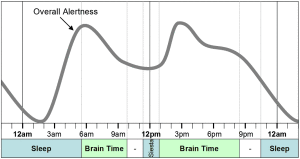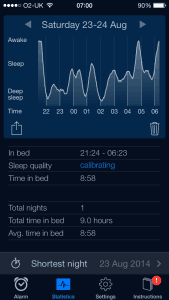Getting Zeds- A Guide to Your Best Nights Sleep
Background.
Our body clock or sometimes referred to as our circadian rhythm runs on a delay of approximately 15 minutes.
There are 24 hours in one day but 24 hours and 15 minutes in one complete cycle of our daily rhythm of hormone peaks and troughs if left unaffected by light. You see, our body clock is brought up to speed by when we are exposed to light and when we eat.
When a baby is born it has very little in the way of a functioning “body clock” and most parents find that over the first 6 months if they are disciplined about bed times and feeding times their spawn (can you tell I don’t have kids yet) soon learn when to be alert and when to relax into a slumber.
We are not too dissimilar.
Having regular eating patterns, and particularly limiting large quantities of protein and fat late into the night, and also managing less exposure to light after sun down is a good place to start.
Chronotype and Jet lag
We are not all the same when it comes to sleeping. Scientists in sleep labs have observed that we each have a propensity to fall asleep and wake up at different times and they call it your chronotype.
Below is a line graph showing level of alertness against time of day.
You can see that in a typical day alertness starts to rise in the early hours of the morning and most people will then wake up between 7am and 9am.
However this can differ from person to person.
The name for somebody who works best on a super early bed time and waking time is an “extreme lark” and the name for somebody who prefers to sleep late and wake late is an “extreme owl”.
Depending on how you fall along this continuum you may identify yourself as a “moderate owl”, “owl” or “extreme owl” and the same goes along the continuum of Larks.
Your chronotype however is simply an advanced or delayed circadian rythym and can in most cases be trained to a point that is more appropriate for your daily schedule.
In the case of travelling to different time zones you will have to do exactly that. Travelling west to east you will have to advance your circadian rythym to happen earlier (known as Phase advance) and travelling east to west you will have to delay it (Phase delay)
This essential just means the same pattern will occur just either it will be behind local time or in front of it, until brought up to speed by when you eat or when you are exposed to light.
Light.
Researches (including a good study by Mc Intyre et al) found that a lack of light later in the evening and before sleep leads to a lack of wakefulness but also that exposure to blue light during earlier times of the day can increase the quality of peoples sleep later that night.
Interestingly the timing, volume, intensity and blueness of light exposure can all be a factor in affecting sleep.
Sasseville did a study called “Blue blocker glasses impede the capacity for bright light to supress melatonin production” which … as the name would suggest showed that limiting the blueness of the light alone can improve sleep quality. This explains why insomnia became a big problem in the early 1900’s following Eddison’s invention of the light bulb in 1879.
There are apps around that will reduce blue light on your web browser or phone like Koala
Sleep stages and Brain Waves
In my earlier article on Coffee I mentioned that sleep should be an absolute tonic for us. Get a deep sleep and it will help you make decisions, learn new skills,be happy and avoid depression, get stronger, drop body fat and keep looking young and sexy.
Don’t get a good kip and all of the good stuff I just mentioned becomes compromised.
How so?
We have 3-4 different stages of sleep depending on who you speak to.
Here’s a screenshot from a kip I had whilst in a pretty big training cycle. The app is sleep cycle
When awake our brain will produce between 12-30 brainwaves per second. Jump into bed and within minutes that number will usually reduce down to around 8-12, this level of brainwave activity is associated with relaxation and meditation, this is stage 1 and it usually lasts about 5 minutes. At this point you will start to reduce your heart rate and your body temperature will lower and the 8-12 brainwaves per second are joined by brief electrical impulses called K- complexes and spindles which appear to play a role in “switching off” motor units within your muscles and reducing awareness of internal and external stimulus like noise, hunger etc. You are now in stage 2.
After about 20 minutes in stage two you will slow your brainwaves down to 1-2 waves per second. You are now in stage 3/4 or deep sleep.
Deep sleep is vital to your psychological and physical health. It’s during deep sleep that we release most growth hormone and collagen both of which are vital for the repair of damaged tissue whether that is muscle tissue or skin.
So if you are looking to get in shape or just look your very best maximising your deep sleep or slow wave sleep is essential.
How do you maximise your deep sleep?
As I mentioned in my previous article building up adenosine in our brain through exercising and thinking is a good way to feel sleepier and sleep well but there are some other substrates that will help you get the most out of your time in bed.
Before that I want to just address a few misconceptions.
Sleep when you’re dead.
When I talk to people I meet about the importance of sleep in learning and health (great craic aren’t I?) some tell me that they have so much to do, and so many people to see that they’ll just sleep when they are dead (some studies suggest they won’t have to wait too long as early mortality is correlated to poor sleeping patterns)
“If I need a really good nights sleep I just pop some sleepers or have a brandy or two”
I have to admit that I was of the opinion once that I could cheat the system and when I needed to just take a zopiclone or two.
The thing about the state that is induced by either is it does not reflect deep sleep. It is more like being unconscious. Towards the end of my rugby career I used to get knocked out a fair bit and I can’t remember ever coming around to say
“Wow, do you know I feel so refreshed!… does my skin look good?”
If you want the benefits of sleep there is no cheating the system you need to find a way to get to that deep sleep!
Here are a list of substrates associated with creating a good nights natural sleep, and which foods are high in them, the list is not exhaustive.
Tryptophan- found in turkey meat, game, eggs and spinach
Zinc- found in red meat, seafood, spinach
5-HTP- This one is a little tough to get through the diet but you can find supplements of 5-HTP pretty easily. I like Phil Richards Amino Relax for this.
Magnesium- Fish, dark leafy greens, nuts and seeds. Again Phil Richards Magnesium Relax is a good source.
Vitamin D- Eggs, sardines, tuna and again you can supplement vitamin D. I use Aliments “Daily D”
So in summary
If you want to get the best nights sleep you can you need to make sure you are exposed to sunlight or a high volume and intensity of blue light during the day. Treat your retina’s and skin like you are a character from Bram Stoker’s Dracula in the evening and make sure you are getting all of the substrates above in your diet.
Do all of the above and watch your skin, muscle and strength reach a new all time high and become the sexual beast that you can be.
I am living proof 😉
If this was useful please like and share and of course if you need some help getting fit and healthy drop us a line.
Spence




Fabulous article on sleep.
Very informative, interesting and useful.
I will definitely be trying out these ideas – probably all of them.
Look out for a more refreshed, energetic and sexier me!